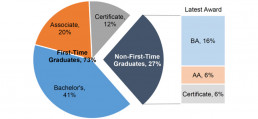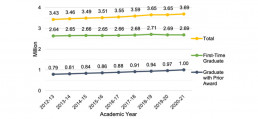Across the globe, industries have experienced unexpected challenges due to the COVID-19
pandemic, and higher education is no different. Burnout, gaps in staff, lack of accessibility to resources, and changes in mental well-being have impacted us all. During the past two years, and especially more recently, colleges have faced additional hurdles to enrollment — declining freshman classes, attrition of faculty/staff, and reduction in resources. With the onslaught of challenges and more uncertainty ahead, leveraging adult learners can give institutions a much-needed boost to their enrollment.
Colleges are seeing a decrease in traditional (under the age of 25) students. According to the National Student Clearinghouse Research Center’s (NSCRC) June 2022 Undergraduate Degree Earners Report, traditional-age students decreased by approximately 25,000 students from the 2019–2020 school year, falling by 0.5%. Instead of enrolling in college right away, many high school graduates are opting to enter the workforce, where they can earn higher wages than companies were paying pre-COVID.
The challenges don’t stop there. Institutions across the country are experiencing the pressure to hit increasing enrollment goals with decreasing resources. Also, fear of a recession has some families rethinking the financial obligation that college requires. Plus, for the last several years, those in enrollment management have been preparing for the looming “enrollment cliff” coming in 2025 due to low birth rates during the 2008 recession, which will result in a prominent decrease in the college-aged population.
All of this paints a bleak picture for college enrollment. However, as with any challenge, there are some opportunities. Specifically, NSCRC’s June 2022 report shows an increase of 1.4% in the population of adult learners. Adults returning to college to hone their crafts, advance in their careers, or prepare for a shift in their careers is a chance for colleges to diversify their college classes, while filling in the enrollment gaps.
Here, I’ll share some ideas to help you reach and connect with adult audiences. Since this is a big topic, I broke this blog into two parts. Read my first two strategies in this post, and then, come back next week when my other two strategies will be released.
2020-21 Graduate Profile (N=3.7M)


Strategy 1: Evaluate Academic Programs
In-Demand Programs
Evaluating and optimizing academic programs to evolve with demand and interest is a critical first step. According to NSCRC, the number of students earning baccalaureate– and associate-level degrees increased by 0.7% and 0.3%, respectively during the 2020–21 academic year. That 0.3% increase in associate level degrees is important, as the previous year saw a 3.7% decline. Take a look at your institution’s offerings, and consider if there are any additional degree programs you may be able to add to meet the changing needs of adult learners.
Modality
Another aspect of a college’s academic program to evaluate is the way the courses are offered. Although a majority of students prefer to have access to some fully online instruction (according to a Digital Learning Pulse Survey, 73% somewhat or strongly agreed that they would like to take some fully online courses in the future) many still prefer in-person learning. Asynchronous courses, meaning the student can access the course content on his or her schedule, are attractive to students who have full-time jobs or are located in other time zones, increasing your pool of potential students.
Strategy 2: Identify Your Population
Digital Strategy
Unlike traditional students, adults aren’t sitting in a high school classroom most of the day, but rather working, traveling to their kids’ practices, participating in committees, and taking care of their families. Identifying the right adult learners for your institution, based on your programs and course modality, takes creativity and strategy. Developing an adult learner marketing strategy that is too broad is a common mistake, resulting in a lukewarm outcome.
Instead, be more specific in your approach to identify and reach the best students for your institution with the best message. For example, using digital media ads that speak directly to that person about the program he/she is interested in will have better results than a general campaign with broad messaging hoping to reach all potential adult learners. You can support these campaigns with personalized microsites or program-specific landing pages that will use targeted messaging that will resonate with each particular audience.
Re-Engage Stop-Outs
The pandemic has impacted the number of students completing their degrees, with many leaving college just short. A recent Gallup-Lumina Foundation survey revealed that 85% of students who left college during the pandemic have considered re-enrolling. Reasons for leaving include decrease in finances, stress, academic concerns, and work obligations. Crafting strategies to address these specific concerns may be the key to getting these students to return to your institution.
Corporate Partners
Many companies offer tuition reimbursement or incentive programs to encourage their employees to obtain a degree. Identifying and forming partnerships with companies can benefit all parties — helping employers attract and retain employees and helping your institution reach its enrollment goals.
Enrolling adult learners is complex, but the ideas shared above should help you start crafting the enrollment strategy you need to be successful. Be on the lookout for my final two strategies in a blog that will be posted in the coming weeks. In the meantime, please feel free to reach out to schedule time to discuss tactics for your institution’s enrollment needs. At Spark451, we can help identify data points, such as socio-economic status, job searches in the college’s area, and other key indicators to help ensure your institution has the programs to attract adult learners and in the modality they prefer, and we can help you identify the right tactics for reaching those prospective students. We’d love to discuss your institution’s specific enrollment challenges and help you develop a plan to fill those gaps.
